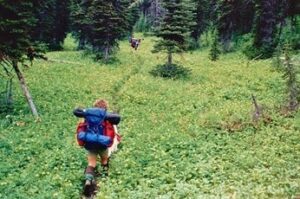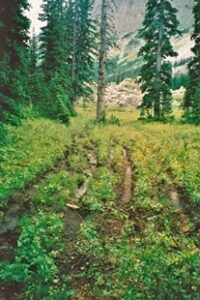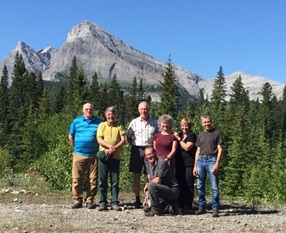by Jenny L. Feick, PhD, Editor of Tales from the Great Divide, Vignettes on the Origins & Early History of Canada’s Great Divide Trail and the Great Divide Trail Association
Although most of the interview dialogue in the book Tales from the Great Divide reveals personal stories about the history of the GDT and the GDTA, some passages also contain opinions on various topics related to long-distance hiking trails. This issue’s excerpts from the 2nd edition of Tales from the Great Divide feature discussions on the benefits of hiking in nature that took place during the interviews in 2018. It seemed appropriate to feature these given the “Walk into Wellbeing” article in this edition of the GDTA’s Pathfinder Newsletter. In the dialogue below, DAVE refers to Dave Higgins, CLIFF to Cliff White, and JENNY to Jenny Feick. The three of us were among the original six who worked on Project: Great Divide Trails in 1974.
Excerpt from Tales from the Great Divide, 2nd Edition from pp 176-177 in “Chapter Four: Early History of the Great Divide Trail Association” in the section on “Tales About the GDTA’s Period of Dormancy, Why did the GDTA Go Dormant?”

DAVE: “Kananaskis Country came into being in 1979, and that supposedly should have helped out matters a bit. That was still during [Peter] Lougheed’s reign, right? Because now all of that country down to the south boundary of the Highwood Divide, the Highwood/Oldman Divide, that was all under higher protection, right?
“So, they barriered off [gated] any roads that went into that area. But they didn’t police it at all, so they still had the maverick dirt bikers and whatever. Plus, a lot of that area was snowmobile zone, and the [Alberta] provincial government was solidly behind it.
“Actually, Alberta Parks was solidly behind the use of the whole Cataract and Lost Creek drainages and part of Baril and Etherington [valleys] as a forest land use zone for snowmobiles. They actually have park crews maintaining the trails up there. But do you think they would spend a dime on a foot trail? Not interested.
“Hikers? ‘Who the hell would ever hike when you’ve got a perfectly serviceable snowmobile or dirt bike or whatever? And who is contributing to the economy around here; people buying machines or those lousy hikers?’ It turns out, statistically, that it’s the lousy hikers by about nine to one, because the hikers include the birdwatchers, other kinds of naturalists. They include anybody; like the mountain biker might be included in that; cross-country skiers, et cetera, et cetera.”198
JENNY: “Non-motorized.”
DAVE: (Nodding) “I found the statistics, they came out of one of our public meetings, the [Alberta] government had the statistics. It turned out that five to six percent of Albertans did any kind of motorized recreation.”
CLIFF: “They’re a noisy five or six percent!”
JENNY: “In many ways.”
DAVE: “At the same time that all this was going on, the [Alberta] government proposed to start charging people for using the cross-country ski trails at Peter Lougheed Provincial Park. That got shot down. That was like a trial run, I think. By then, we already knew that that was a healthier activity than driving a snowmobile. But they are perfectly willing to groom snowmobile trails at public expense. Cross country ski trails? Not on your life!”

198 Editor’s Note: See Nichols Applied Management Inc. 2018 in Appendix C for a report documenting that the economic contribution from non-motorized recreation in Alta. Total around $515 million annually.
Reference from Appendix C:
Nichols Applied Management Inc. 2018. The Economic Impact of Non-Motorized Recreation in Alberta. Apr. 11, 2018. Ottawa, Ont.: The Outdoor Council of Canada. Accessed online on Apr. 3, 2020 at http://www.albertatrailnet.com/wordpress/wp-content/uploads/Economic-Impact-of-Non-Motorized-Outdoor-Rec-in-Alberta-April-2018.pdf

L-R: Lani Smith, Cliff White, Dave Higgins, Jenny Feick, Jeff Gruttz (kneeling), Mary Jane Kreisel (Née Cox), and Dave Zevick
Excerpt from Tales from the Great Divide, 2nd edition from pp 235/236 in “Chapter Six: Reflections – Then and Now”, and pp 313, 316 and 319 in “Appendix C: Annotated Bibliography”
DAVE: “Just to put a wrap on this, really, the very recent medical and scientific evidence indicates pretty clearly that walking, and more specifically hiking, has spectacular value in terms of our physical health.”
JENNY: “And mental health.”
DAVE: “And mental health, social well-being. There’s more and more conclusive evidence coming out in studies that shows the value of this250, to the point where you could easily argue that anything you do in terms of funding or other kinds of supports for facilities that encourage hiking pay you back several times over and reduce medical and other social costs, confinement like prisons, you name it, right? And this kind of activity, we barely understand how beneficial it is, other than we can see anecdotally. All of us know people who have lived to 100 years old because they walked and walked and walked. Or, like I say, more specifically, they used natural settings for their walks.”
250 Editor’s Note: Just do an online search on the internet with keywords such as physical and mental benefits of hiking in nature and you will find numerous articles from peer-reviewed journals (see Keniger et al. 2013 and Frumkin 2001) in Appendix C for two examples), as well as interpretations of the research in books, popular magazines, newspapers, websites, and blogs (see Rubenstein 2015 in Appendix C).
References from Appendix C:
Frumkin, Howard. 2001. “Beyond Toxicity, Human Health and the Natural Environment”, Am J Prev Med. 20(3): 234-240.
Keniger, Lucy E., Gaston, Kevin J., Irvine, Katherine N., and Fuller, Richard A. 2013. “What are the Benefits of Interacting with Nature?” Int. J. Environ. Res. Public Health. 10(3): 913-935.
Rubenstein, Dan. 2015. Born to Walk, The Transformative Power of a Pedestrian Act. ECW Press, Toronto, Ont.
What is Tales from the Great Divide and How Can I Get a Copy?
Tales from the Great Divide, Vignettes on the Origins and Early History of Canada’s Great Divide Trail and Great Divide Trail Association is a self-published compendium of stories from individuals involved firsthand in the start and development of the GDT and the GDTA. First published in September 2019, Tales from the Great Divide brings to life the memories of many of the ‘originals’ whose vision, idealism, dedication, and hard work over five decades made Canada’s Great Divide Trail a reality. Transcripts of interviews and storytelling sessions, combined with excerpts from letters and other documents and hundreds of photographs and illustrations, reveal the adventurous, heartbreaking, and hilarious moments that characterized the early history of the GDT. Devising and establishing a route for this wilderness long-distance trail along the crest of the Canadian Rocky Mountains demonstrated naive courage and optimism. These pathfinders faced personal hardships and their trail work took place at a time before lightweight gear existed and without technological aids such as GPS, inReach, cell phones, or satellite phones. In their quest to establish the GDT with a protected corridor, they confronted numerous threats and challenges. The first edition is out of print but a pdf can be ordered from the Nature Wise Consulting website for $11.00.
The Second Edition of Tales from the Great Divide (416 pages, 300+ images) includes more than 100 pages of new material, over 100 additional images, and other enhancements. It also corrects errors found in the first edition after it was printed. The second edition was completed in 2021. It is the definitive reference book on the history of the GDT and the GDTA.
There are now five ways people can obtain a copy of the second edition of Tales from the Great Divide:
- Order a print-on-demand version from Amazon for Cdn $85.00 (rate in US$ varies with the exchange rate) plus shipping (free for Amazon Prime members).
- Purchase the book from one of the independent bookstores selling it (The Whyte Museum of the Canadian Rockies in Banff, Alberta, Crockett’s Trading Company in Bellevue, Alberta, Four Point Books in Invermere, B.C. Prices vary depending on the bookstore.
- Contact Geartrade, which operates the official GDTA online store. They sell the book for $80.00.
- Arrange to purchase a printed copy directly in person from Jenny Feick, the editor, in the Invermere area or Dave Higgins in Calgary for Cdn $65.00 (shipping anywhere in Canada would cost $20.00). To set this up, please email jenny.feick@gmail.com .
- Order a PDF version from the Nature Wise Consulting website for Cdn $25.00 – https://naturewise.me/consulting/product/tales-from-the-great-divide-second-edition/ .

